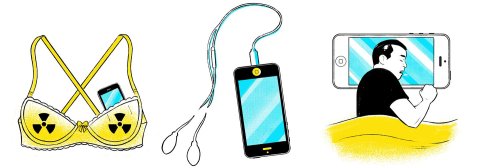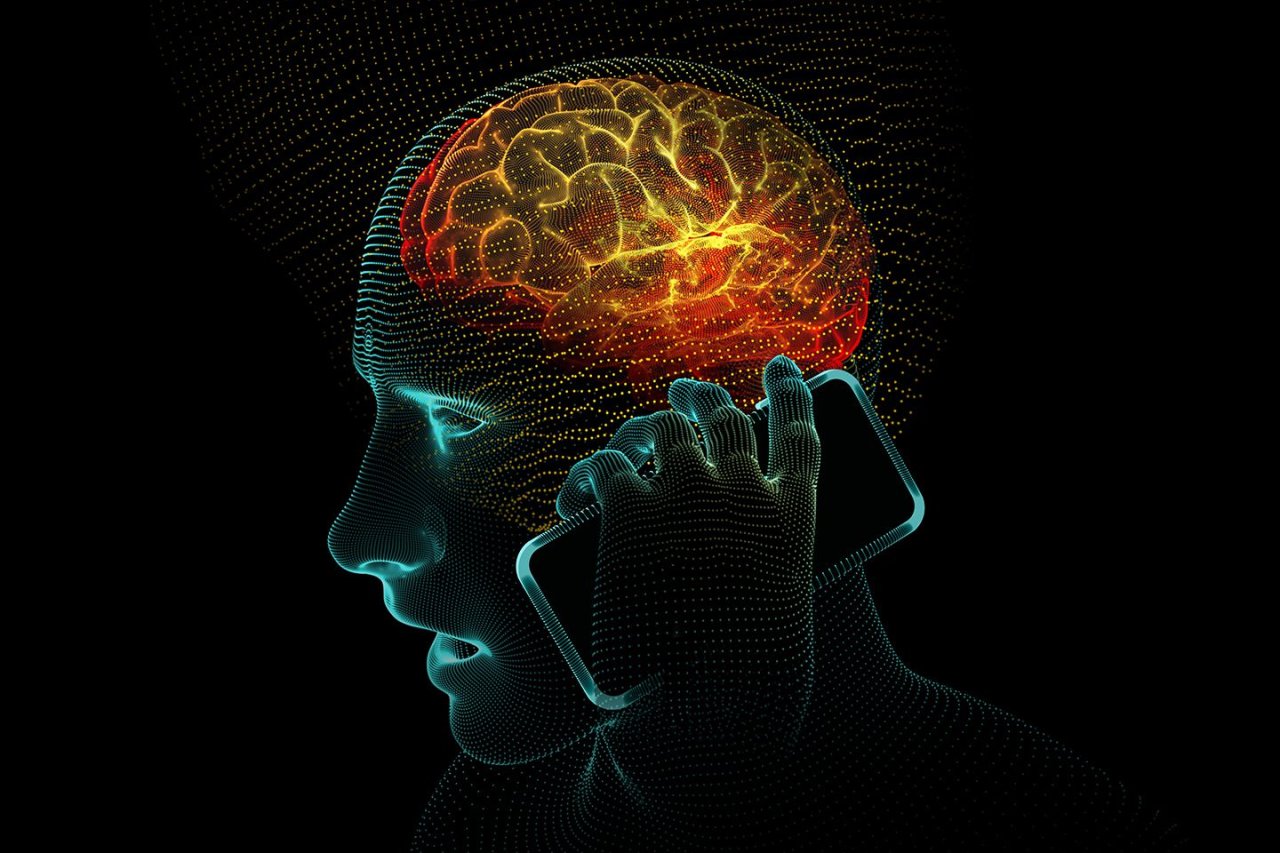Tiffany Frantz got her first cellphone when she was 16.
She loved that flip phone. Every morning, on her way out the door, she'd slip it into the left cup of her bra. When she was 21, while watching television one night with her parents in their Lancaster, Pennsylvania, living room, she felt a lump the size of a pea in her left breast, just beneath her phone. Tests later showed four cancerous tumors. "How in the world did this happen?" her mother asked.
Dr. John West believes he knows. In 2013, the Southern California breast cancer surgeon and five other doctors wrote in the journal Case Reports in Medicine about Frantz's tumors and those of three other young women. Each of them regularly carried a cellphone in her bra. "I am absolutely convinced," West tells Newsweek, "that there is a relationship between exposure to cellphones and breast cancer in young women who are frequent users."
West has no proof, however. His evidence is anecdotal—and though anecdotes can spur a hypothesis, they can't prove one. For years, scientists have looked for a link between cancer and cellphone use that holds up to scientific rigor, and they've come up short. That's why when West told his theory to a gathering of about 60 breast cancer specialists, they dismissed the connection as mere coincidence. "I'm hoping that someday people will say, 'Well, we laughed at him, and now he's vindicated,'" he says.
Just because West can't prove he's right doesn't mean he's wrong. After some studies suggested an increased risk of one type of brain cancer, the World Health Organization (WHO) concluded in 2011 that cellphones are "possibly carcinogenic" and recommended keeping "a close watch for a link between cellphones and cancer risk." But without conclusive evidence of harm, regulators have held back.
Meanwhile, cellphone use has exploded. In 1986, 681,000 Americans had a cellphone. In 2016, there were 396 million subscriptions to cellphones in the U.S.—more than one for every adult and child. Teenagers, whose developing bodies and brains put them at the most risk, are the most eager adopters. According to a Pew Research Center survey earlier this year, 95 percent of 13- to 17-year-olds said they had access to a smartphone, a 22 percent jump from 2012. A generation has grown up with cellphones—teething on them as toddlers, carrying them through middle school in their jean pockets and even sleeping with them under their pillows. All told, 5 billion people around the world now use a cellphone.
In a few decades, we might know for sure whether or not cellphones cause cancer. In the meantime, we are basically running a large, uncontrolled experiment on ourselves.

A Worrying Drumbeat
Scientists have clung to one reassuring point: According to everything we know about physics and biology, cellphones should not cause cancer. The radio waves they emit are "nonionizing," meaning they don't damage our DNA the way ultraviolet light from the sun or X-rays do. They emit similar radiation to microwave ovens but not nearly at the level of strength required to warm leftover pasta—or cook brain cells. (In the early days, research focused on the potential of cellphone radiation to heat tissues of the body, and safety regulations were developed to respond to this concern.) But there is no known mechanism by which radiation emanating from a phone would interact with brain or breast cells to cause cancer.
Still, the typical phone user's level of exposure troubles health officials. Cellphone transmitters have to be strong enough to reach a cellphone tower as far away as 22 miles, which means the intensity of the signal at point-blank range is high. Holding a cellphone next to your ear increases the intensity of the radiation by 10,000 times, compared with holding it 6 inches away. Most of us are like Frantz: We press our phones against our ears, close to our brain tissue. For hours every day, we tuck them into our waistbands and pockets, near our reproductive and digestive organs.
Studies linking cancer and cellphone use have been inconclusive, at least in part because of the challenges of conducting research. Cancers tend to develop slowly, and cellphones have been used for barely a generation. It's possible that effects simply haven't shown up yet. And to come to a definitive conclusion, scientists would have to look at a large population and isolate cellphones as a cause for cancers, which is exceedingly difficult.
The U.S. telecommunications industry has not made cellphone usage data available to researchers, which would help in doing population studies. A spokesperson for the CTIA, a wireless telephone industry group, declined to answer specific questions but offered a general statement: "The scientific evidence shows no known health risk to humans due to the [radio-frequency] energy emitted by cellphones." The spokesperson also cited U.S. brain tumor statistics, which show "that since the introduction of cellphones in the mid-1980s, the rate of brain tumors in the United States has decreased." That's accurate—but the trend hides tumor-rate increases in areas near where people hold their cellphones to talk—namely, in the frontal and temporal lobes and the cerebellum. A 2012 study in the journal World Neurosurgery showed increases in a particularly deadly type of cancer in those areas between 1992 and 2006 in California, despite a decline in other parts of the brain. In one part, it increased by nearly 12 percent a year.
A 2014 French study, published in the journal Occupational and Environmental Medicine, looked at 447 people who had developed brain tumors, both benign and malignant, and compared them to a control group. Overall, the study found no association between brain tumors and cellphones. It did show that heavy users—those who used the phones for 896 hours or more in their entire lives—were more likely to develop tumors. But only 37 people fell into this category, which is too small a sample size to establish a link. And like many studies of links between disease and behavior, the French research relied on surveys in which test subjects were asked to remember how much time they spent on their phones, which can be unreliable.
A group of toxicologists took a different tack. They sidestepped the task of determining whether cellphones cause cancer and addressed a much simpler question: Is it possible that cellphone-like radiation could produce a cancerous tumor?

Rats Take a Bath in Radio Waves
In a concrete basement in Chicago, researchers at the National Toxicology Program (NTP), a part of the U.S. Department of Health and Human Services, exposed more than 3,000 rats and mice to the same kind of radio-frequency radiation that cellphones emit. The study, which cost $25 million, was designed to test the plausibility that cellphone radiation could induce tumors in animals—to find out if there was some mechanism by which supposedly harmless radio waves could interact with cells.
The scientists decided to expose the rodents to radiation for more time than a typical user would be on a cellphone. They gave the rodents 10-minute blasts of radiation, followed by 10 minutes of rest, for nine hours a day. The rodents also got higher-intensity radiation than most cellphone users would get. The lowest dosage corresponded roughly to the maximum amount a cellphone user would encounter—1.5 watts per kilogram. The maximum allowed for cellphone users by the Federal Communications Commission (FCC) is 1.6 watts per kilogram, which occurs only when a phone is struggling to establish a connection with a cellphone tower. "Energy levels of emissions during a typical call are much lower than this highest permitted level," said John Bucher, a senior scientist at the NTP, at a press conference earlier this year.
The researchers also exposed the animals to much higher dosages. Rats got as much as 6 watts per kilogram, and mice topped out at 10 watts per kilogram. To make matters worse for the rodents, the radiation was administered to their entire bodies, exposing all their organs—brains, hearts, livers, digestive tracks—to high levels of radiation. The radiation given to the rodents was so powerful, their body temperatures had to be monitored with microchips implanted under their skin to make sure they weren't being heated like popcorn in a microwave. Even at the highest levels, temperatures never rose more than 1 degree Celsius, so the scientists could rule out heating as a cause of any damage from radio waves.
The radiation had a significant effect. After bombarding the rodents with radio waves for two years, from 2014 to 2016, the scientists evaluated their health and compared groups that got high exposures of radio waves with control groups that got none. Male rats exposed to the highest level of radiation developed 6 percent more malignant heart tumors than those in the control group that received no radiation. (Females, for reasons that aren't clear, showed no such effect.) What's more, the rate at which the rats developed malignant heart tumors increased with the intensity of the exposure. The rats that got 1.5 watts per kilogram developed four tumors, but those that got 6 watts per kilogram got 11. That the occurrence of tumors increases with dosage suggests that the radiation is a significant factor.
Bucher cautions that the results cannot be extrapolated to humans who use cellphones. But it shows that something happens to animal cells when they are bombarded for a long time with strong radio waves. The study, Bucher tells Newsweek, "established that there could be effects of radio-frequency radiation that are potentially relevant for human health risks."
One of the puzzling, and potentially worrying, twists in the results concerns the type of cells that were affected. Tumors appeared in Schwann cells, which surround nerve cells. The particular Schwann cells that showed tumors in the rat study were located in the rodents' hearts. But Schwann cells exist throughout the body—in the head, in the breast, in the reproductive organs, in many areas that tend to get heavy exposure to cellphone radiation.
The discovery was especially concerning because prior epidemiological studies have shown that heavy cellphone users were more likely to develop rare brain tumors in the same kind of cells. In March, Italian researchers published another study, in the journal Environmental Research, with strikingly similar results. Scientists at the Ramazzini Institute also bombarded rats, 2,448 of them, with radio-frequency radiation for 19 hours a day over their lifetimes. Like the Chicago basement rats, the Italian male rats exposed to the highest exposure of radio-frequency radiation were significantly more likely to develop tumors in Schwann cells in their hearts.
A panel of academics and pharmaceutical industry experts reviewed the findings of the NTP study and in March concluded that, in the case of male rats, it showed "clear evidence of carcinogenic activity." Dr. De-Kun Li, a senior research scientist at the Kaiser Permanente Division of Research in Oakland, California, described the preliminary NTP findings as "stunningly important." And Dr. Otis Brawley, chief medical officer of the American Cancer Society, called them a "game changer."
The program results, issued in preliminary form earlier this year, set off a flurry of calls from public health advocates for the WHO to upgrade its classification of cellphone radiation from "possibly" to "probably" carcinogenic. But, as Brawley tells Newsweek, "it still leaves us with some huge holes." Why, for example, were male rats more likely to get tumors than female rats? And why did rats exposed to radio-frequency radiation generally live longer than unexposed rats? Most important, if cellphone radiation causes cancer, how does it do it?
"These studies should have been done before more than 90 percent of Americans, including children, started using radio-frequency-based technologies and devices day in and day out," said Olga Naidenko, a senior science adviser with the Environmental Working Group, a nonprofit in Washington, D.C.
What's Next
From a regulatory perspective, it's too early to know what steps to take to protect the public from harm, says Bucher. He now believes there is a mechanism by which cellphone radiation could cause cancer. Until he identifies the mechanism, though, he can't offer advice about how to engineer phones to prevent the problem. He is working on additional studies he hopes will offer clues by next year.
Dr. Gabriel Zada, a neurosurgeon and professor at the Keck School of Medicine of USC, is developing pilot experiments to test possible mechanisms by which cellphone emissions could turn normal but susceptible cells into cancerous ones. In one, he installed a working smartphone inside a box shielded from radiation. A glass bottle containing human brain tumor cells sits next to the phone. The rig is one in a series Zada plans to build to control the effect of radio-frequency emissions on different cell types.
While Zada and Bucher work on the next phase of study into the health effects of cellphone radiation, public health advocates continue to await final results and recommendations from the NTP study. They are scheduled to be released this fall, nearly two decades after the U.S. Food and Drug Administration (FDA) commissioned the research.
In a 2012 report to Congress, the U.S. Government Accountability Office called for a reassessment of exposure and testing requirements for mobile phones to reflect current use, the latest research and international safety recommendations. The report prompted the FCC to open a formal inquiry into the need to re-examine exposure limits, which it last did in 1996, long before Apple introduced the iPhone. As of 2016, the agency had collected about 900 comments on the question, but it has so far taken no action.
Current cellphone safety regulations are based on a premise that is now arguably false: that cellphone radiation can cause harm only by heating tissue. The FDA, however, has no plans to strengthen the regulations. It has "confidence that the current safety limits for cellphone radiation remain acceptable for protecting public health," said Dr. Jeffrey Shuren, director of the FDA's Center for Devices and Radiological Health, in a statement issued after the NTP's results were released. "We have not found sufficient evidence that there are adverse health effects in humans caused by exposures at or under the current radio-frequency energy exposure limits."
Many other nations have stricter safety rules than the U.S. Since the WHO warning in 2011, at least eight countries—including France, Germany, Switzerland, India and Israel—have issued guidelines intended to reduce consumers' exposure to radiation. Belgium, France and Israel banned the sale of cellphones designed for children, and others have forbidden advertising aimed at children.
The American Academy of Pediatrics urged the FCC and the FDA to reassess standards for cellphones and wireless products in 2013. "Children are not little adults and are disproportionately impacted by all environmental exposures, including cellphone radiation," wrote Dr. Thomas McInerny, then president of the academy. The group now urges parents to limit their children's and teenagers' cellphone use and warns: "Cellphone manufacturers can't guarantee that the amount of radiation you're absorbing will be at a safe level."
In the absence of revised regulations and standards, I called Brawley on his cellphone to see if he had any advice. "Wear an earpiece," he said. As he spoke those words, he was holding his cellphone to his head.
Editor's note: This article was changed to reflect the fact that the NTP radiation study produced an increase in malignant heart tumors, not tumors overall, and that the amount of radiation delivered was in watts per kilogram.















